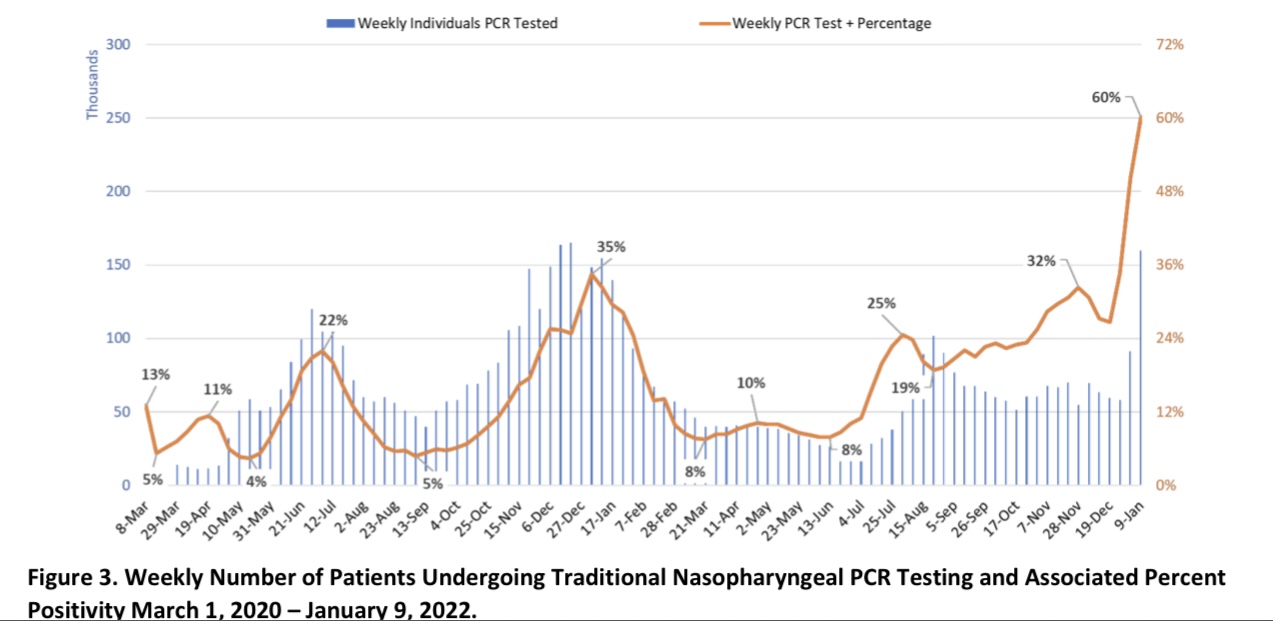View the Full Epidemiology & Hospital Occupancy Report
Arizona is experiencing historic levels of community transmission attributable to the newly dominant Omicron variant. Test positivity is insanely high (60%) reminding us that test capacity, accessibility, and/or uptake is wholly inadequate. Arizona, like much of the United States, is in the midst of another large pandemic wave. Expect transmission to peak in late January with very large numbers of hospitalizations continuing into February. The greatest burden on our health care system will shift towards emergency departments and general wards and away from our ICU facilities.
As of January 9th, new cases were being diagnosed at a rate of 1494 cases per 100K residents per week. Given the experience of eastern states, we can expect this rate to likely peak in the ballpark of 3000 cases per 100K residents per week before the end of the month. Given it is now January 15th, rates are considerably higher as your read this in the moment. For example, the ADHS Dashboard recorded a whopping 24,964 cases on January 15th which is roughly equivalent to 175,000 per week!
Mask mandates were needed at municipal and county levels to reduce transmission, blunt the worst of the Omicron wave, and relieve overwhelmed hospitals. Now, hospitals will just have to grin and bear it.
COVID-19 hospital occupancy is once again increasing and should continue to do so throughout January. Hospitals should prepare for >30% occupancy in general wards and in the ICU. Access to care will continue to be further restricted in the face of staff shortages owing to infections among healthcare workers. However, healthcare workers have told to “suck it up, Buttercup” and work even if COVID-19 positive.
January, and perhaps early February, will be hospital’s most difficult month with the tail of the Delta wave, below average but still meaningful seasonal influenza, and a large Omicron surge.
Weekly COVID-19 deaths have now reached 500 per week and should remain at or below this level as the tail end of the Delta wave recedes. So far, 25068 Arizonans have lost their lives to COVID-19.
- Risk factors for breakthrough hospitalization and death were recently elucidated in the British Medical Journal: https://www.bmj.com/content/374/bmj.n2244. These findings were replicated in the MMWR with poor outcomes among those age >40 years, immunocompromised or with underlying chronic illness. https://www.cdc.gov/mmwr/volumes/71/wr/mm7101a4.htm
- While not ideal, the 2-dose Pfizer primary sequence provided 70% protection against hospitalization in South Africa during their Omicron Therefore, our immunity wall may hold just enough to prevent collapse of our hospital systems, but it will be close https://www.nejm.org/doi/full/10.1056/NEJMc2119270
- The CDC recently documented the largest decline in US life expectancy in 75 years https://www.cdc.gov/nchs/products/databriefs/db427.htm. Higher mortality rates were observed for all age groups >15 years of age highlighting that COVID-19 is not just impacting the elderly.
- The United Kingdom continues to publish excellent summaries of Omicron’s impact (Jan 14): https://assets.publishing.service.gov.uk/government/uploads/system/uploads/attachment_data/file/1046853/technical-briefing-34-14-january-2022.pdf
Editorial Note: I’ll spare you any editorial notes this week. At this point, one just has to throw their hands up and say- well, if these circumstances won’t convince Ducey & Herrington to do anything, nothing will.


